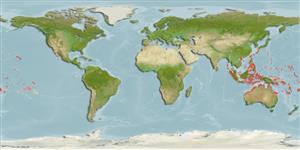>
Blenniiformes (Blennies) >
Blenniidae (Combtooth blennies) > Salariinae
Etymology: Entomacrodus: Greek, ento = inside + Greek, makros = big + Greek, odous = teeth (Ref. 45335); caudofasciatus: Name from Latin 'cauda' for tail and 'fasciatus' meaning with bars, referring to the caudal-fin color pattern of the species (R. Bajol, pers. Comm. 11/14).
More on author: Regan.
Environment: milieu / climate zone / depth range / distribution range
Écologie
marin récifal; profondeur 0 - 3 m (Ref. 30874). Tropical; 32°N - 31°S
Indo-Pacific: Andamans to Ducie Islands, north to southern Japan, south to Cocos-Keeling, Kermadec, and Rapa Islands; Belau and Marshall Islands in Micronesia.
Taille / Poids / Âge
Maturity: Lm ? range ? - ? cm
Max length : 6.2 cm SL mâle / non sexé; (Ref. 1602)
Description synthétique
Clés d'identification | Morphologie | Morphométrie
Épines dorsales (Total) : 13; Rayons mous dorsaux (Total) : 14 - 16; Épines anales: 2; Rayons mous anaux: 15 - 17.
Facultative air-breathing (Ref. 126274); Adults are found along rocky intertidal shorelines, benches, outer reef flats, and reef margins subject to some degree of wave action. Feeds on filamentous algae (Ref. 89972). Oviparous. Eggs are demersal and adhesive (Ref. 205), and are attached to the substrate via a filamentous, adhesive pad or pedestal (Ref. 94114). Larvae are planktonic, often found in shallow, coastal waters (Ref. 94114).
Life cycle and mating behavior
Maturité | Reproduction | Frai | Œufs | Fécondité | Larves
Oviparous, distinct pairing (Ref. 205).
Myers, R.F., 1991. Micronesian reef fishes. Second Ed. Coral Graphics, Barrigada, Guam. 298 p. (Ref. 1602)
Statut dans la liste rouge de l'IUCN (Ref. 130435: Version 2024-2)
Menace pour l'homme
Harmless
Utilisations par l'homme
Outils
Articles particuliers
Télécharger en XML
Sources Internet
Estimates based on models
Preferred temperature (Ref.
123201): 24.7 - 29.3, mean 28.5 °C (based on 1763 cells).
Phylogenetic diversity index (Ref.
82804): PD
50 = 0.5000 [Uniqueness, from 0.5 = low to 2.0 = high].
Bayesian length-weight: a=0.00776 (0.00356 - 0.01695), b=3.00 (2.81 - 3.19), in cm total length, based on LWR estimates for this (Sub)family-body shape (Ref.
93245).
Niveau trophique (Ref.
69278): 2.0 ±0.00 se; based on food items.
Résilience (Ref.
120179): Haut, temps minimum de doublement de population inférieur à 15 mois (Preliminary K or Fecundity.).
Fishing Vulnerability (Ref.
59153): Low vulnerability (10 of 100).
Nutrients (Ref.
124155): Calcium = 234 [108, 447] mg/100g; Iron = 1.01 [0.54, 1.87] mg/100g; Protein = 17.8 [16.5, 19.1] %; Omega3 = 0.0749 [, ] g/100g; Selenium = 16.5 [7.1, 41.0] μg/100g; VitaminA = 140 [33, 612] μg/100g; Zinc = 3.29 [2.05, 5.07] mg/100g (wet weight);
